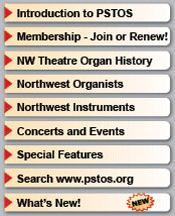


Columbia Theatre - 3/22 Kimball & 2/9 Wurlitzer, Style 210
106 SW Sixth Street
Portland, Oregon
Back to the Oregon Original Theatre Installations page

Sixth Avenue, Columbia Theatre on left, pre-1916
Two different organs were installed at the Columbia Theatre:
According to Jim Stettner, the Kimball was a 3-manual, 22-rank tubular-pneumatic instrument with a 3-rank Echo division.
That organ was moved in 1920 by an undocumented person or firm to Sunnyside Congregational Church at 3210 SE Taylor St. in Portland and installed as is. In 1934, the congregation changed its name to Staub Memorial Congregational in honor of their founding Swiss pastor, Rev. J.J. Staub.
In 1949, Balcom and Vaughan electrified the organ as their opus 489. The original attached console was detached from the case, taken to Seattle, and filled-out with new panels to make it a free-standing console. All of the chest pneumatics were releathered and treated with sperm oil. The manual keys and pedalboard were retained, and the manuals were fitted with new key contacts. The pneumatic coupler system was replaced with an electric coupler system. New expression and crescendo rollers and shoes were installed. The latest electric stopkeys replaced the original Kimball stop tablets. And a new recorder-type combination action was added. The "new" console was air-free. Further work was done by Balcom and Vaughan in 1955 as their opus 555, but the exact nature of this work is uncertain.
At an unknown time, Staub Mem. Congregational ceased to exist and the building was sold to a group named City Church. That group merged in 1978 with another group and the building became known as Portland Bible Fellowship.
In 1986, Portland Bible Fellowship sold the organ to Redeemer Lutheran in Gresham, OR. for $5,500.00. - who placed it in storage pending installation in their new sanctuary. However, it was later ascertained that the organ was too large and would either require substantial down-sizing of the instrument, expensive rebuilding with new chests to fit the space, or substantial modifications to the building. The organ was offered for sale again.
In 1992, Dr. Ernie Ford of Auburn, WA acquired the organ for $2,000.00. The original chests had suffered water damage while in storage, and were not salvageable. Balcom and Vaughan built new electro-mechanical chests and a down-sized instrument was installed in side-by-side chambers in Dr. Ford's home in 1993 with some new ranks added. The console was also upgraded with new equipment at the time of the rebuild in 1993. Some of the unused ranks were stored in Dr. Ford's garage. Other ranks were given to a friend who also wished to build a home instrument, but those ranks have since been returned to Dr. Ford. According to Jim Stettner, as of 2007, the organ is still owned by Dr. Ford.
In an email dated December 17, 2012 Greg Clanton of Minnetonka MN provided some clarification of the church name changes:
"In the change in church names the progression was City Church (a renaming of Staub Memorial) merged with Portland Bible Fellowship and changed its name to Community Bible Fellowship. I was one of the elders involved in that change."
According to William Hansen, the Wurlitzer was installed in two expression boxes which would indicate that the theatre had no chambers.
Available records indicate that the theatre was renovated in 1923 and that the Wurlitzer was moved to Portland's Peoples (Alder St, Music Box) Theatre. In later years, Colonel Woodlaw owned the theatre and eventually donated the organ to the Shrine Temple. It was later sold to Frank Alexander for $500.00 and installed in his home by Bob Rickett. After Frank's death, the organ was sold to Andy Crow of Olympia, Washington. Andy installed it in the home of one of his friends.

A rainy 6th Avenue, Columbia Theatre signage at end of street, date unknown.

WWI parade passing under the Columbia Theatre signage, c.1915. Columbia Theatre on left.

Postcard view of Sixth Avenue, Columbia Theatre on left, pre-1916. Note this postcard was made from the top photo above.

Another parade showing the Columbia signage, c.1915
About this site © PSTOS, 1998-2014